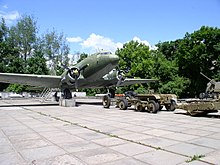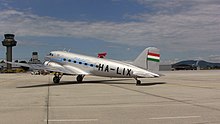Lissunov Li-2
| Lissunov Li-2 | |
|---|---|
 A Lissunow Li-2 in Malév paint |
|
| Type: | Transport plane |
| Design country: | |
| Manufacturer: |
Plant No. 84 in Khimki, from 1941 in Tashkent |
| Commissioning: |
1939 |
| Production time: |
1938-1952 |
| Number of pieces: |
6,157 or 4,937 (depending on the source) |
The Lisunov Li-2 ( Russian Лисунов Ли-2 , NATO reporting name : "Cab" ) is a in the Soviet Union made twin-engine passenger and cargo plane that has a licensed version of the American Douglas DC-3 and the Second World War in large Scope was used. The spelling Lisunow Li-2 is often found in other sources . The Li-2, which is powered by two piston engines, does not have a pressurized cabin .
history
In 1937, the Soviet Union acquired the license rights for the US DC-3 (it was subsequently announced that the Soviets never paid royalties to the manufacturing company Douglas ). Under the direction of Boris Lisunov , a development team was commissioned to tailor this type to Soviet requirements. The group, which included Vladimir Myasishchev and Mikhail Gurevich , had already traveled to the United States a year earlier to conduct negotiations. The entire dimensions of the DC-3 were then transferred to the metric system . This is how the PS-84 (Passaschirski Samoljot, passenger aircraft, 84 is the number of the manufacturer) was created, which had a slightly reduced wingspan and a slightly increased empty weight, and the side door was moved to the right side of the fuselage. In addition, less powerful 1000 hp motors were used, which reduced the top speed considerably compared to the DC-3 , but increased the range by over 400 kilometers.
In 1938 series production began in Khimki near Moscow. From mid-1939, the PS-84 was put into service with Aeroflot and remained the airline's most important commercial aircraft until 1947. In the course of its service life, the number of passengers to be carried was increased from 14 to a maximum of 28.
When the German Reich attacked the Soviet Union in 1941, many PS-84s were fitted with a rotating UTK-1 weapon stand with a 7.62 mm MG SchKAS , later with a 12.7 mm MG UBK and from 17 onwards. September 1942 the designation Li-2 . During the war, the Li-2 was the standard transport aircraft of the Soviet Union and also took on tasks for partisan supply in the occupied territories, the dropping of paratroopers ( Li-2D ) and the transport of the wounded.
A version called the Li-2WW (Wojenny Wariant, military variant) received a SchKAS machine gun in the bow and in two specially modified hatches on both sides of the hull and was used as a front bomber. In addition, the Li-2 received outer weapon stations for up to four 250 kg bombs. Often lighter bomb calibers were also carried inside the fuselage, which the crew simply threw out of the cargo hatch.
After the end of the war, the Li-2 were converted back to normal transport aircraft and also used in Eastern Bloc countries, including the VR Poland , where they were used as Li-2T (sb) training bombs until 1960. The machines used in Yugoslavia received Pratt & Whitney R-1830 engines and the designation Li-3 . In the USSR, the machines were replaced by the Il-12 , but they flew in the polar air fleet until the 1970s. In 1956, the Li-2W, designed as a weather plane for great heights, was created .
According to Soviet figures, an estimated 3,000 Li-2s were built .
construction
The Li-2 was a cantilever low -wing aircraft produced in all-metal construction with a rectangular three-spar central wing and trapezoidal outer wing with hydraulic landing flaps. The tail unit was also self-supporting and of normal construction. The rear landing gear was retractable, whereby the main wheels could only be retracted halfway into the engine pods. In winter, it was possible to convert to snow runners .
Li-2 today
The Li-2 may still be used by the North Korean Air Force today. Allegedly these planes are stationed at the "Sondok" airfield, which can be proven by satellite photos . Whether these are actually flyable aircraft of the type Li-2 cannot be said with absolute certainty.
At the moment there is another Li-2 in Europe in an airworthy condition. After five years of restoration by a private association, it is used for sightseeing flights during the summer months, and is occasionally a guest at trade fairs (such as the International Aerospace Exhibition Berlin and Aero Friedrichshafen ) throughout Europe. It bears the registration number HA-LIX and is stationed at Budaörs airfield , a suburb of Budapest . Today (2006) a total of five pilots have a type rating (the so-called type rating) for the machine; this was specially redefined based on the old experiences of former Li-2 pilots, as well as from still existing manuals, some of which are in Russian and handwritten.
It is noteworthy that this aircraft still flies completely with the original instrumentation, apart from new, contemporary radios and a retrofitted GPS receiver.
Although it is a licensed replica, in practice the aircraft has little in common with a DC-3. The flight performance is significantly lower due to other (significantly less powerful) engines, the Russian instrumentation requires special training and the entire aircraft also differs in many details from its American counterpart. Therefore, the procurement of spare parts with new parts is increasingly problematic. In Budaörs there are three more Li-2s, at least two of which serve as spare parts donors.
Another machine was also restored in Budaörs for later exhibition in a museum, but is not airworthy. There is a small open-air museum in front of the Terminal 2 building of Budapest Airport Ferihegy , in which, among other exhibits, another Li-2 is on display. This is a former military aircraft, which, however, now appears in the Malév livery due to the main sponsor of this museum .
Numerous aircraft of the same type can be viewed in various other museums, for example in Moscow ( Monino ), Kiev and Krakow .
variants
| Soviet Union | |
| PS-84 | Original passenger plane (Passascherski Samoljot) with 14 to 28 seats. In contrast to the DC-3, a slightly smaller wingspan, slightly higher curb weight, side door on the right side and weaker engines |
| Li-2 | Military transport aircraft with retrofitted defensive armament (designation from September 17, 1942) |
| Li-2D | Version of the Li-2 for dropping paratroopers (1942) |
| Li-2WW | Bomber version (Wojenny Wariant) of the Li-2 (1942) |
| Li-2W | Version of the Li-2 designed as a weather aircraft for great heights (1956) |
| Yugoslavia | |
| Li-3 | Li-2 with retrofitted original US DC-3 engines of the Pratt & Whitney R-1830 type |
| Poland | |
| Li-2T (sb) | Practice bomb aircraft based on the Li-2 |
Incidents
During the operating time of the Li-2 there were 197 total losses that became known up to October 2017 (most recently in 2004). 1108 people died. This list is incomplete and has only just begun (November 2017). Examples:
- On November 5, 1946, bad weather conditions and chaotic conditions at the air traffic control at Moscow-Vnukowo Airport resulted in three crashes of Aeroflot passenger planes within less than 50 minutes , after the planes each flew around the airport for more than 2 hours and ran out of fuel . Two of the aircraft that crashed were Li-2 aircraft (see also Aeroflot aircraft accident of Lissunow Li-2 CCCP-L4181 and Aeroflot aircraft accident of Lissunow Li-2 CCCP-L4207 ) .
- On November 15, 1951, a Li-2P of the Polish LOT (registration number SP-LKA ) collided with a high-voltage line shortly after taking off from Łódź near Górki Duże near Tuszyn and crashed. Due to engine problems, the commander decided not to continue the onward flight. However, he was probably forced to do so by officers of the Polish Ministry of Security. All 16 people on board died (see also LOT flight accident near Tuszyn ) .
- On August 12, 1951, Li-2 crashed Aeroflot (registration CCCP-L4314 ) for a dual engine failure during airfield Vilyuysk from. Two of the sixteen people on board died.
- Another Li-2 accident occurred on December 27, 1951 and claimed 20 lives : an aircraft accident near Namzew .
- On January 2, 1965, an Aeroflot plane crashed on the flight from Ashgabat to Taschauz, killing all 24 occupants (see also Aeroflot flight 112 ) .
Technical specifications
| Parameter | PS-84 | Li-2WW |
|---|---|---|
| crew | 4th | 5-6 |
| Passengers | 14-24 | no |
| length | 19.65 m | |
| span | 28.81 m | |
| height | 5.15 m | |
| Wing area | 91.70 m² | |
| Undercarriage track width | 5.63 m | |
| Empty mass | 7,700 kg | 7,650 kg |
| Payload | 3,000 kg | k. A. |
| Takeoff mass | 10,700 kg | 11,700 kg |
| Travel (march) speed | Max. 220 km / h | 240 km / h |
| Top speed | 280 km / h | 270 km / h |
| Landing speed | 110 km / h | 108 km / h |
| Climb performance | 5 m / s | k. A. |
| Wing loading | 116.6 kg / m² | k. A. |
| Power load | 5.3 kg / hp | k. A. |
| Take-off / landing runway | 400 m / 390 m | |
| Service ceiling | 5,600 m | |
| Range | Max. 2,200 km with full payload 1200 km |
2,200 km |
| Engines | two air-cooled 9-cylinder radial engines - M-62IR | |
| power | Starting output each 735.5 kW (1,000 PS) continuous output each 618 kW (840 PS) |
|
| Tank capacity | 3,110 l | k. A. |
| Armament | no | three 7.62 mm MG SchKAS one 12.7 mm MG UBK RS-82 or RS-132 air-to-surface missiles under the wings with up to 1,000 kg bombs |
| Bomb load | no | normal 1,000 kg max. 2,000 kg for short trips |
See also
Web links
- Interactive 360-degree panorama in a Lissunow Li-2 Flugtage Bautzen 2010
- On the road with the Soviet DC-3
Individual evidence
- ^ Ulrich Langer: Luftfahrtdaten 1976 . In: Flieger-Jahrbuch 1978 . Transpress, Berlin 1977, p. 165 .
- ↑ accident statistics Lisunov Li-2 , Aviation Safety Network (English), accessed on 10 November 2017th
- ^ Accident report Li-2 SP-LKA , Aviation Safety Network (English), accessed on November 10, 2017.
- ^ Accident report Li-2 CCCP-L4314 , Aviation Safety Network (English), accessed on November 10, 2017.
- ^ Heinz A. F. Schmidt: Soviet aircraft . Transpress , Berlin, p. 58 .
- ^ Wilfried Copenhagen: Soviet bomb planes . Transpress, Berlin 1989, ISBN 3-344-00391-7 , pp. 150 .




